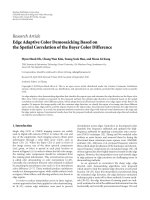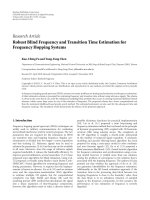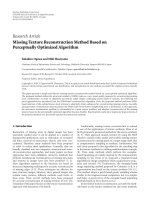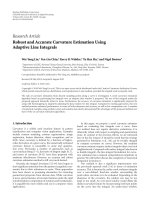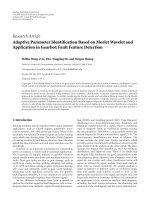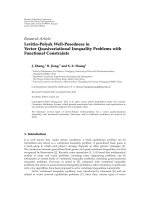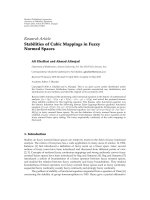Báo cáo sinh học: " Research Article Robust Real-Time Background Subtraction Based on Local Neighborhood Patterns" pot
Bạn đang xem bản rút gọn của tài liệu. Xem và tải ngay bản đầy đủ của tài liệu tại đây (6.63 MB, 7 trang )
Hindawi Publishing Corporation
EURASIP Journal on Advances in Signal Processing
Volume 2010, Article ID 901205, 7 pages
doi:10.1155/2010/901205
Research Article
Robust Real-Time Background Subtraction Based on
Local Neighborho od Patterns
Ariel Amato, Mikhail G. Mozerov, F. Xavier Roca, and Jordi Gonz
`
alez
Computer Vision Center (CVC), Universitat Autonoma de Barcelona, Campus UAB Edifici O, 08193 Bellaterra, Spain
Correspondence should be addressed to Mikhail G. Mozerov,
Received 1 December 2009; Accepted 21 June 2010
Academic Editor: Yingzi Du
Copyright © 2010 Ariel Amato et al. This is an open access article distributed under the Creative Commons Attribution License,
which permits unrestricted use, distribution, and reproduction in any medium, provided the original work is properly cited.
This paper describes an efficient background subtraction technique for detecting moving objects. The proposed approach is able to
overcome difficulties like illumination changes and moving shadows. Our method introduces two discriminative features based on
angular and modular patterns, which are formed by similarity measurement between two sets of RGB color vectors: one belonging
to the background image and the other to the current image. We show how these patterns are used to improve foreground detection
in the presence of moving shadows and in the case when there are strong similarities in color between background and foreground
pixels. Experimental results over a collection of public and own datasets of real image sequences demonstrate that the proposed
technique achieves a superior performance compared with state-of-the-art methods. Furthermore, both the low computational
and space complexities make the presented algorithm feasible for real-time applications.
1. Introduction
Moving object detection is a crucial part of automatic
video surveillance systems. One of the most common and
effective approach to localize moving objects is background
subtraction, in which a model of the static scene background
is subtracted from each frame of a video sequence. This
technique has been actively investigated and applied by
many researchers during the last years [1–3]. The task of
moving object detection is strongly hindered by several
factors such as shadows cast by moving object, illuminations
changes, and camouflage. In particular, cast shadows are the
areas projected on a surface because objects are occluding
partially or totally direct light sources. Obviously, an area
affected by cast shadow experiences a change of illumi-
nation. Therefore in this case the background subtraction
algorithm can misclassify background as foreground [4, 5].
Camouflage occurs when there is a strong similarity in color
between background and foreground; so foreground pixels
are classified as background. Broadly speaking, these issues
rise problems such as shape distortion, object merging, and
even object losses. Thus a robust and accurate algorithm to
segment moving object is highly desirable.
In this paper, we present an adaptive background model,
which is formed by temporal and spatial components. These
components are basically computed by measuring the angle
and the Euclidean distance between two sets of color vectors.
We will show how these components are combined to
improve the robustness and the discriminative sensitivity
of the background subtraction algorithm in the presence
of (i) moving shadows and (ii) strong similarities in color
between background and foreground pixels. Another impor-
tant advantage of our algorithm is its low computational
complexity and its low space complexity that makes it feasible
for real-time applications.
The rest of the paper is organized as follows. Section 2
introduces a brief literature review. Section 3 presents our
method. In Section 4 experimental results are discussed.
Concluding remarks are available in Section 5.
2. Related Work
Many publications are devoted to the background subtrac-
tion technique [1–3]. However in this section we consider
only the papers that are directly related to our work.
Haritaoglu et al. state that in W4 [6] the background
is modeled by representing each pixel by three values: its
minimum and maximum intensity values and the maximum
intensity differences between consecutive frames observed
2 EURASIP Journal on Advances in Signal Processing
during this training period. Pixels are classified as fore-
ground if the differences between the current value and
the minimum and maximum values are greater than the
values of the maximal interframe difference. However, this
approach is rather sensitive to shadows and lighting changes,
since the only illumination intensity cue is used and the
memory resource to implement this algorithm is extremely
high.
Horprasert et al. [7] implement a statistical color
background algorithm, which use color chrominance and
brightness distortion. The background model is built
using four values: the mean, the standard deviation, the
variation of the brightness, and chrominance distortion.
However, this approach usually fails for low and high
intensities.
Kim et al. [8] use a similar approach as [7], but they
obtain more robust motion segmentation in the presents of
the illumination and scene changes using background model
with codebooks. The codebooks idea gives the possibility
to learn more about the model in the training period. The
authors propose to cope with the unstable information of
the dark pixels, but still they have some problems in the
low- and the high-intensity regions. Furthermore, the space
complexity of their algorithm is high.
Stauffer and Grimson [9] address the low- and the high-
intensity regions problem by using a mixture of Gaussians to
build a background color model for every pixel. Pixels from
the current frame are checked against the background model
by comparing them with every Gaussian in the model until a
matching Gaussian is found. If so, the mean and variance of
the matched Gaussian are updated; otherwise a new Gaussian
with the mean equal to the current pixel color and some
initial variance is introduced into the mixture.
McKenna et al. [10] assume that cast shadows result
in significant change in intensity without much change in
chromaticity. Pixel chromaticity is modeled using its mean
and variance and the first-order gradient of each background
pixel modeled using gradient means and magnitude vari-
ance. Moving shadows are then classified as background
if the chromaticity or gradient information supports their
classification.
Cucchiara et al. [11]useamodelinHue-Saturation-
Value (HSV) and stress their approach in shadow suppres-
sion. The idea is that shadows change the hue component
slightly and decrease the saturation component significantly.
In the HSV color space a more realistic noise model can
be done. However, this approach also has drawbacks. The
similarity measured in the nonlinear HSV color space usually
generates ambiguity at gray levels. Furthermore threshold
handling is the major limitation of this approach.
3. Proposed Algorithm
A simple and common background subtraction procedure
involves subtraction of each new image from a static model
of the scene. As a result a binary mask with two labels
(foreground and background) is formed for each pixel in
the image plane. Broadly speaking, this technique can be
separated in two stages, one dealing with the scene modeling
and another with the motion detection process. The scene
modeling stage represents a crucial part in the background
subtraction technique [12–17].
Usually a simple unimodal approach uses statistical
parameters such as mean and standard deviation values, for
example, [7, 8, 10], and so forth. Such statistical parameters
are obtained during a training period and then these are
dynamically updated. In the background modeling process
the statistical values depend on both the low- and high-
frequency changes of the camera signal. If the standard
deviations of the low- and high-frequency components of
the signal are comparable, methods based on such statistical
parameters exhibit robust discriminability. When the stan-
dard deviation of the high-frequency change is significantly
less than the low-frequency change, then the background
model can be improved to make the discriminative sensitivity
much higher. Since a considerable change in the low-
frequency domain is produced for the majority of real video
sequences, we propose to build a model that is insensitive
to low-frequency changes. The main idea is to estimate
only the high-frequency change per each pixel value as
one interframe interval. The general background model in
this case can be explained as the subtraction between the
current frame and the previous frame, which suppose to
be the background image. Two values for each pixel in the
image are computed to model background changes during
the training period: the maximum difference in angular and
Euclidean distances between the color vectors of the consec-
utive image frames. The angular difference is used because
it can be considered as photometric invariant of color
measurement and in turn as significant cues to detect moving
shadows.
Often pixelwise comparison is not enough to distinguish
background from foreground and in our classification
process we further analyze the neighborhood of each pixel
position. In the next section we give a formal definition of
the proposed similarity measurements.
3.1. Background Scene Modeling
3.1.1. Similarity Measurements. Four similarity measure-
ments are used to compare a background image with a
current frame.
(i) Angular similarity measurement Δθ between two
color vectors p(x)andq(x) at position x in the RGB
color space is defined as follows:
Δθ
p
(
x
)
, q
(
x
)
=
Cos
−1
p
(
x
)
·q
(
x
)
p
(
x
)
q
(
x
)
. (1)
(ii) Euclidean distance similarity measurement ΔI be-
tween two color vectors p(x)andq(x) in the RGB
color space is defined as follows:
ΔI
p
(
x
)
, q
(
x
)
=
p
(
x
)
−q
(
x
)
.
(2)
EURASIP Journal on Advances in Signal Processing 3
R
p
Bg
ΔI
p
f
Δθ
G
B
(a)
|p
Bg
| < |p
f
|
Y
|p
Bg
| > |p
f
|
γ
I
T
I
γ
S
T
I
γ
θ
T
θ
XX
Foreground
Background
Shadow
(b)
Figure 1: (a) Angle and magnitude difference between two color vector in RGB space. (b) Difference in angle and magnitude in 2D “polar
difference space.” The axes are computed as x
= ΔI · cos(Δθ)andy = ΔI ·sin(Δθ).
0
5
10
15
20
25
30
35
Error (%)
1234
Sequences
Our approach
K.Kim
Horprasert
W4
Staurf and Grimson
False positive error
(a)
0
5
10
15
20
25
Error (%)
1234
Sequences
Our approach
K.Kim
Horprasert
W4
Staurf and Grimson
False negative error
(b)
Figure 2: Segmentation errors. (a) FPE and (b) FNE.
For each of the described similarity measurements a
threshold function is associated:
Tθ
Δθ, θ
T
=
⎧
⎨
⎩
1, if Δθ>θ
T
,
0, otherwise,
TI
ΔI, I
T
=
⎧
⎨
⎩
1, if |ΔI| >I
T
,
0, otherwise,
(3)
where θ
T
and I
T
are intrinsic parameters of the
threshold functions of the similarity measurements.
To describe a neighbourhood similarity measure-
ment let us first characterize the index vector x
=
(n, m)
t
∈ Ω ={0, 1, , n, , N;0,1, ,m, , M},
which define the position of a pixel in the image.
Also we need to name the neighbourhood radius
vector w
= (i, j)
t
∈ W ={−W, ,0,1, ,
i, , W;
−W, ,0,1, , j, , W}, which define
the positions of pixels that belong to the neighbour-
hood relative to any current pixel. Indeed, the domain
W is just a square window around a chosen pixel.
(iii) Angular neighborhood similarity measurement ηθ
between two sets of color vectors in the RGB color
4 EURASIP Journal on Advances in Signal Processing
(a) (b)
(c) (d)
Figure 3: (a) Original image, segmentation result of (b) our method, (c) Stauffer method, and (d) K. Kim method.
space p(x + w)andq(x + w)(w ∈ W)canbewritten
as
ηθ
ϑ, θ
T
=
w∈W
Tθ
Δθ
(
ϑ
)
, θ
T
,
(4)
where Tθ, θ
T
,andΔθ are defined in (3)and(1),
respectively, and ϑ is (p(x + w), q(x + w)).
(iv) Euclidean distance neighborhood similar ity measure-
ment μI between two sets of color vectors in the RGB
color space p(x + w)andq(x + w)(w
∈ W)canbe
written as
μI
ϑ, I
T
=
w∈W
TI
ΔI
(
ϑ
)
, I
T
,
(5)
where TI, I
T
,andΔI are defined in (3)and
(2), respectively. With each of the neighbourhood
similarity measurements we associate a threshold
function:
Tηθ
ηθ
(
ϑ
)
, η
T
=
⎧
⎨
⎩
1, if ηθ
(
ϑ
)
>η
T
,
0, otherwise,
TμI
μI
(
ϑ
)
, μ
T
=
⎧
⎨
⎩
1, if μI
(
ϑ
)
>μ
T
,
0, otherwise,
(6)
where η
T
and μ
T
are intrinsic parameters of the
threshold functions of the neighborhood similarity
measurements.
3.1.2. Scene Modeling. Our background model (BG) will
be represented with two classes of components, namely,
running components (RCs) and training components (TCs).
The RC is a color vector in RGB space and only this
component can be updated in running process. The TC is
a set of fixed thresholds values obtained during the train-
ing.
The background model is represented by
BG
(
x
)
=
p
(
x
)
,
T
θ
(
x
)
, T
I
(
x
)
,W
,(7)
where T
θ
(x) is maxima of the chromaticity variation; T
I
(x)
is maxima of the intensity variation; W is the half size of the
neighbourhood window.
A training process has to be performed to obtain
the background parameters defined by (7). This first step
consists of estimating the value of the RC and TC during
the training period. To initialize our BG we put the RC
=
{
p
0
(x)} as the initial frame. T
θ
(x) and T
I
(x) are estimated
during the training period by computing the angular differ-
ence and the Euclidean distance between the pixel belonging
to the previous frame and the pixel belonging to the current
frame:
T
θ
(
x
)
= max
f ∈{1,2, ,F}
Δθ
p
f −1
(
x
)
, p
f
(
x
)
,
T
I
(
x
)
= max
f ∈{1,2, ,F}
ΔI
p
f −1
(
x
)
, p
f
(
x
)
,
(8)
where F is the number of frames in the training period.
EURASIP Journal on Advances in Signal Processing 5
(1)
(2)
(3)
(4)
(5)
(6)
(7)
(a) (b) (c)
Figure 4: Sample visual results of our background subtraction algorithm in various environment. (a) Background Image, (b) Current
Image, and (c) Foreground (red) /Shadows (green) /Background (black) detection. (1) PETS 2009 View 7, (2) PETS 2009 View 8, (3) ATON
(Laboratory), (4) ISELAB (ETSE Outdoor), (5) LVSN (HallwayI), (6) VSSN, and (7) ATON (Intelligentroom).
6 EURASIP Journal on Advances in Signal Processing
3.2. Classification Process. Our classification rules consist of
two steps.
Step One. Pixels that have strong dissimilarity with the
background are classified directly as foreground, in the case
when the following rule expression is equal to 1 (TRUE):
Fr
(
x
)
= Tθ
Δθ
p
bg
(
x
)
, p
f
(
x
)
, γ
θ
∩
TI
ΔI
p
bg
(
x
)
, p
f
(
x
)
, γ
I
,
(9)
where γ
θ
and γ
I
are experimental scale factors. Otherwise,
when (9) is not TRUE, the classification has to be done in the
following step.
Step Two. This step consists of two test rules. One verifies a
test pixel for the shadow class (10) and another verifies for
the foreground class (11):
Sh
(
x
)
= TμI
μI
p
bg
(
x + w
)
, p
f
(
x + w
)
, γ
I
T
I
(
x
)
, k
I
F
∩
p
bg
(
x
)
>
p
f
(
x
)
∩
1 −Tηθ
ηθ
p
bg
(
x + w
)
, p
f
(
x + w
)
, γ
θ
T
θ
(
x
)
, k
θ
S
∩
1 −TμI
μI
p
bg
(
x + w
)
, p
f
(
x + w
)
, γ
S
T
I
(
x
)
, k
I
S
,
(10)
Fr
(
x
)
= TμI
μI
p
bg
(
x + w
)
, p
f
(
x + w
)
, γ
I
T
I
(
x
)
, k
I
F
∩
(
1
−Sh
(
x
))
.
(11)
The rest of the pixels that are not classified as shadow
or foreground pixels must be classified as background
pixels. Figure 1 illustrates the classification regions. All the
implemented thresholds were obtained on the base of a
tuning process with different video sequences (γ
θ
= 10
◦
, γ
I
=
55, γ
I
= 10, γ
θ
= 2
◦
, γ
S
= 80 and K
I
F
= K
θ
S
= K
I
S
= 1).
3.3. Model Updating. In order to maintain the stability of
the background model through the time, the model needs
to be dynamically updated. As it was explained before, only
the RCs have to be updated. The update process is done at
every frame, but only in the case when the updated pixels are
classified as a background. The model is updated as follows:
p
bg
c
(
x, t
)
= βp
bg
c
(
x, t
−1
)
+
1−β
p
f
c
(
x, t
)
, c
∈{R, G, B},
(12)
where (0 <β<1) is the updated rate. Due to our
experiments the value of this parameter has to be β
= 0.45.
4. Experimental Results
In this section we present the performance of our approach
in terms of quantitative and qualitative results applied to 5
well-known datasets taken from 7 different video sequences:
PETS 2009 ( (View 7 and 8)),
ATON ( (Laboratory and
Intelligentroom)), ISELAB ( (ETSE
Outdoor)), LVSN ( />(HallwayI)), and VSSN, (-
augsburg.de/VSSN06
OSAC/).
Quantitative Results. We have applied our proposed algo-
rithm in several indoor and outdoor video scenes. Ground-
truth masks have been manually extracted to numerically
evaluate and compare the performance of our proposed
technique with respect to most similar state-of-the-art
approaches [6–9]. Two metrics were considered to evaluate
the segmentation results, namely, False Positive Error (FPE)
and False Negative Error (FNE). FPE means that the back-
ground pixels were set as Foreground while FNE indicates
that foreground pixels were identified as Background. We
show this comparison in terms of accuracy in Figure 2:
Error
(
%
)
=
No. of misclassification pixels
No. of correct foreground pixels
×100%.
(13)
Qualitative Results. Figure 3 shows a visual comparison
between our techniques and some well-known methods.
It can be seen that our method performs better in terms
of camouflage areas segmentation and suppressing strong
shadows. In Figure 4 also visual results are shown. In this
case we have applied our method in several sequences. It
can be seen that the foreground objects are detected without
shadows, in such a way preserving their shape properly.
5. Conclusions
This paper proposes an efficient background subtraction
technique which overcomes difficulties like illumination
changes and moving shadows. The main novelty of our
method is the incorporation of two discriminative similarity
measures based on angular and Euclidean distance patterns
in local neighborhoods. Such patterns are used to improve
foreground detection in the presence of moving shadows
and strong similarities in color between background and
foreground. Experimental results over a collection of public
and own datasets of real image sequences demonstrate the
effectiveness of the proposed technique. The method shows
an excellent performance in comparison with other methods.
Most recent approaches are based on very complex models
designed to achieve an extremely effective classification;
however these approaches become unfeasible for real-time
applications. Alternatively, our proposed method exhibits
low computational and space complexities that make our
proposal very appropriate for real-time processing in surveil-
lance systems with low-resolution cameras or Internet web-
cams.
EURASIP Journal on Advances in Signal Processing 7
Acknowledgments
This work has been supported by the Spanish Research Pro-
grams Consolider-Ingenio 2010:MIPRCV (CSD200700018)
and Avanza I+D ViCoMo (TSI-020400-2009-133) and by
the Spanish projects TIN2009-14501-C02-01 and TIN2009-
14501-C02-02.
References
[1] M. Karaman, L. Goldmann, D. Yu, and T. Sikora, “Compar-
ison of static background segmentation methods,” in Visual
Communications and Image Processing, vol. 5960 of Proceedings
of SPIE, no. 4, pp. 2140–2151, 2005.
[2] M. Piccardi, “Background subtraction techniques: a review,”
in Proceedings of the IEEE International Conference on Systems,
Man and Cybernetics (SMC ’04), vol. 4, pp. 3099–3104, The
Hague, The Netherlands, October 2004.
[3] A. McIvor, “Background subtraction techniques,” in Proceed-
ings of the International Conference on Image and Vision
Computing, Auckland, New Zealand, 2000.
[4] A. Prati, I. Mikic, M. M. Trivedi, and R. Cucchiara, “Detecting
moving shadows: algorithms and evaluation,” IEEE Transac-
tions on Pattern Analysis and Machine Intelligence, vol. 25, no.
7, pp. 918–923, 2003.
[5]G.ObinataandA.Dutta,Vision Systems: Segmentation
and Pattern Recognition, I-TECH Education and Publishing,
Vienna, Austria, 2007.
[6] I. Haritaoglu, D. Harwood, and L. S. Davis, “W4: real-time
surveillance of people and their activities,” IEEE Transactions
on Pattern Analysis and Machine Intelligence, vol. 22, no. 8, pp.
809–830, 2000.
[7] T. Hoprasert, D. Harwood, and L. S. Davis, “A statistical
approach for real-time robust background subtraction and
shadow detection,” in Proceedings of the 7th IEEE International
Conference on Computer Vision, Frame Rate Workshop (ICCV
’99), vol. 4, pp. 1–9, Kerkyra, Greece, September 1999.
[8] K. Kim, T. H. Chalidabhongse, D. Harwood, and L. Davis,
“Real-time foreground-background segmentation using code-
book model,” Real-Time Imaging, vol. 11, no. 3, pp. 172–185,
2005.
[9] C. Stauffer and W. E. L. Grimson, “Learning patterns of
activity using real-time tracking,” IEEE Transactions on Pattern
Analysis and Machine Intelligence, vol. 22, no. 8, pp. 747–757,
2000.
[10]S.J.McKenna,S.Jabri,Z.Duric,A.Rosenfeld,andH.
Wechsler, “Tracking groups of people,” Computer Vision and
Image Understanding, vol. 80, no. 1, pp. 42–56, 2000.
[11] R. Cucchiara, C. Grana, M. Piccardi, A. Prati, and S. Sirotti,
“Improving shadow suppression in moving object detection
with HSV color information,” in Proceedings of the IEEE
Intelligent Transportation Systems Proceedings, pp. 334–339,
Oakland, Calif, USA, August 2001.
[12] K. Toyama, J. Krumm, B. Brumitt, and B. Meyers, “Wallflower:
principles and practice of background maintenance,” in Pro-
ceedings of the 7th IEEE International Conference on Computer
Vision (ICCV ’99), vol. 1, pp. 255–261, Kerkyra, Greece,
September 1999.
[13] A. Elgammal, D. Harwood, and L. S. Davis, “Nonparametric
background model for background subtraction,” in Proceed-
ings of the European Conference on Computer Vision (ECCV
’00), pp. 751–767, Dublin, Ireland, 2000.
[14] A. Mittal and N. Paragios, “Motion-based background sub-
traction using adaptive kernel density estimation,” in Proceed-
ings of the IEEE Computer Society Conference on Computer
Vision and Pattern Recognition (CVPR ’04), vol. 2, pp. 302–309,
Washington, DC, USA, July 2004.
[15] Y T. Chen, C S. Chen, C R. Huang, and Y P. Hung,
“Efficient hierarchical method for background subtraction,”
Pattern Recognition, vol. 40, no. 10, pp. 2706–2715, 2007.
[16] L. Li, W. Huang, I. Y H. Gu, and Q. Tian, “Statistical modeling
of complex backgrounds for foreground object detection,”
IEEE Transactions on Image Processing, vol. 13, no. 11, pp.
1459–1472, 2004.
[17] J. Zhong and S. Sclaroff, “Segmenting foreground objects from
a dynamic textured background via a robust Kalman filter,”
in Proceedings of the 9th IEEE International Conference on
Computer Vision (ICCV ’03)
, pp. 44–50, Nice, France, October
2003.
